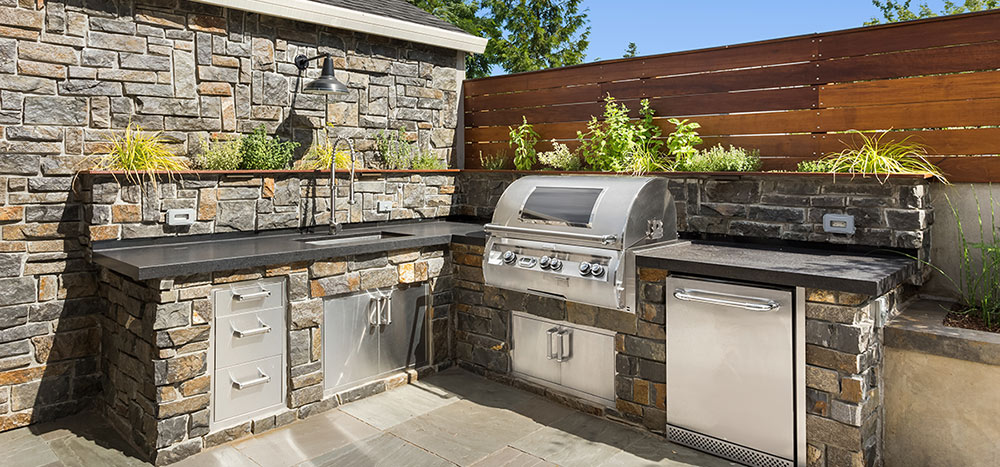
Tips for Creating a Beautiful Outdoor Room
Nothing says summer in the Hudson Valley like enjoying a drink and grilled food on a warm night under the stars. To make the most of this natural ambiance, many homeowners choose to upgrade their backyard to a true outdoor living space, adding inviting features like hardscaping, a firepit, kitchen area with grill, roofing, and upgraded seating.
This type of home improvement is becoming more popular. Natural Living magazine reports that 70 percent of architectural firms surveyed by the American Institute of Architecture said there has been significant growth in the popularity of outdoor living spaces, and predicted that they will become “the norm for newly built homes.”
Additionally, a recent survey by the National Kitchen & Bath Association “found that 60 percent of homeowners with existing outdoor living spaces plan to upgrade them for better functionality and improved aesthetics.” Among these projects, outdoor kitchens led the way in popularity, with 76 percent of respondents planning “a new or upgraded outdoor cooking area.”
Thinking about adding or upgrading an outdoor living space at your home? Here are some ideas to keep in mind.
1. Form follows function
Unless you plan to add every available amenity, it’s best to prioritize and base your purchases around that. From there, you can economize on other features, or add them in future years.
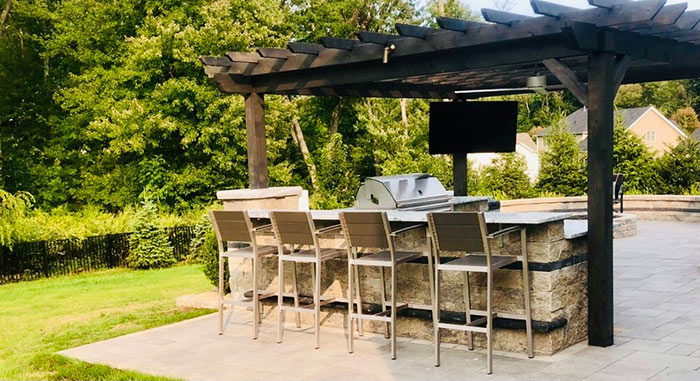
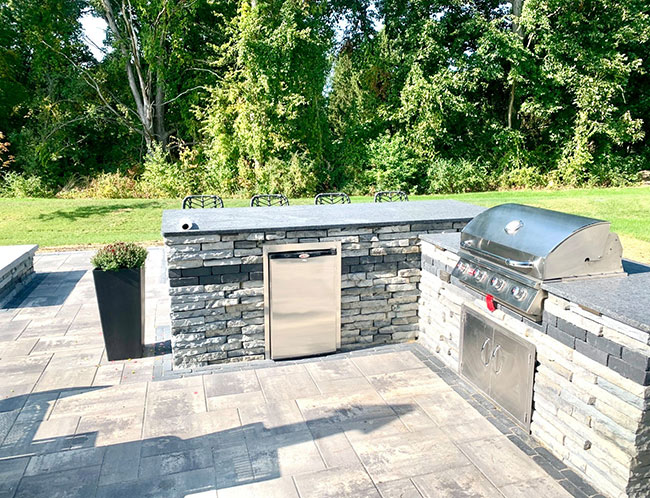
Some examples of outdoor cooking areas with high-top seating and built-in refrigeration. (Photo courtesy Harmony Hill Landscaping)
Will your new space be mainly used for cooking and dinner parties? Then focus on the kitchen and dining areas. A counter area with a built-in gas grill, a small refrigerator and sink give you everything you need to prepare and serve food and drinks without having to go in and out of your home. (A built-in gas grill is definitely a premium feature, but if you have natural gas, you’ll benefit from the fact that natural gas grills cost about 1/3 as much to operate as propane.)
Jennifer Halstead, co-owner with husband Jarod Halstead of Harmony Hill Landscaping Inc. in Fishkill, suggests including stools adjacent to the grilling area so you can continue interacting with your guests while preparing the feast, with an outdoor dining table and chairs in another area for the sit-down meal.
If you’ll be using your outdoor space for a lot of family gatherings, you can create areas to occupy children with “built-in sandboxes, water features, or play stations,” according to Natural Living.
If the area will mainly be used by you to relax, upgraded seating with a fire pit or fireplace would be ideal. Which brings us to point 2…

Gas fire pits offer the benefits of a campfire without the smoke or cleanup, and can be lit with the push of a button.
2. The power of fire
Anyone who has ever been camping knows there’s nothing like gathering with friends around a fire; it seems to tap into something from our ancient roots. So it’s natural that fire pits and fireplaces are some of the most popular features for outdoor living spaces. In addition to providing a natural focal point to gather around, the heat they give off also helps to extend the season for outdoor entertainment — a feature whose importance was demonstrated during the Covid-19 pandemic.
Wood can be used for the fuel but it has some drawbacks; ignition isn’t quick, it generates smoke, and creates ash that requires frequent cleanup and produces embers than can be a fire hazard if there’s anything flammable nearby. Propane and natural gas installations have the virtues of push-button ignition, and smoke-less and spark-free combustion, so you can use them on a deck or near wooden furniture. Natural gas has the further advantages of lower cost and greater convenience; because it’s delivered on-demand, you never have to worry about run out mid-soiree.
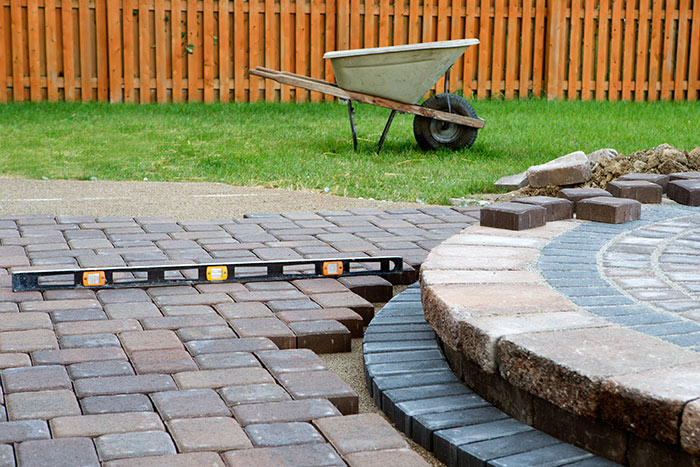
Stone is a popular choice for outdoor room floors because it looks attractive and won’t crack due to ice like concrete.
3. Keep off the grass
Being in an outdoor room without flooring is just… being outdoors. Some sort of “hardscaping” (like pavers, a wooden deck, even artificial grass) is essential to define the space, and ensures your guests won’t find themselves with wet or muddy shoes. Poured concrete has a tendency to crack due to our freeze-thaw cycles in the Northeast, so pavers are a common choice.
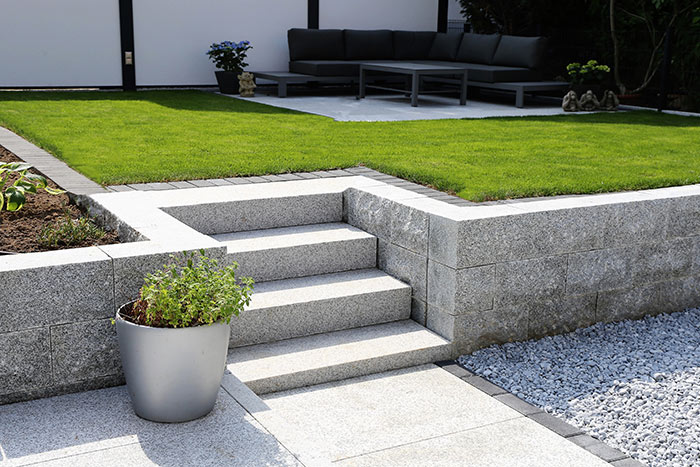
A small difference in elevation can create separation between different areas in your outdoor living space.
4. Create separate areas
Just as a rug or different wall colors can create a division of space within a single large indoor room, there are tricks to partitioning your outdoor room based on use. For example, you could have one area (like the grill and kitchen) a bit higher than the dining area; just a couple steps will do the trick.
If you have a pool, you might want to screen off the portion where you store towels and other supplies. Planting a tall hedge or fence would accomplish this.
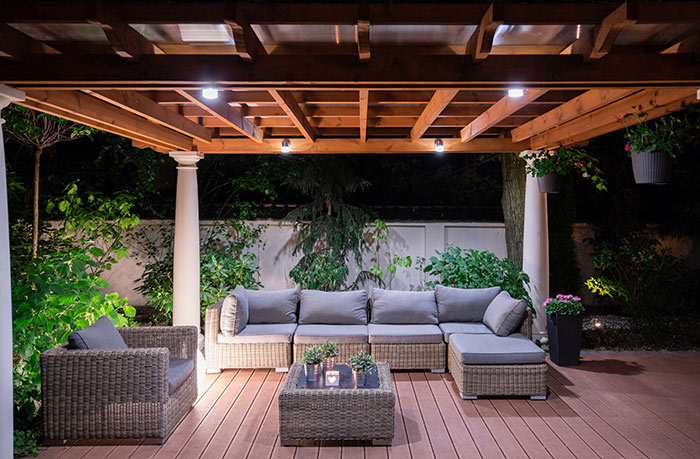
A roof isn’t necessary to provide shade, but it is a better choice if you want to put nicer furniture or run an electric line to the sheltered area. (Photo courtesy Harmony Hill Landscaping)
5. Provide cover
Some sort of shaded area is essential to make your backyard space more comfortable. Without it, a hot sunny day will have your guests seeking refuge indoors. A common solution is a pergola, which is composed of pillars supporting overhead crossbeams without a roof. (An arbor is similar, but part of it attaches to the house rather than being free-standing.) The area beneath is shaded thanks to the angle of the beams, which also offer a place for climbing plants to grow. (However, Halstead warns against doing plantings in areas whose main function is dining due to their tendency to attract insects and drop plant material in your food.)
To create a rain-proof area, you can simply attach polycarbonate or aluminum roofing to the top. Having a ceiling also opens up the possibility of running electricity to the structure and installing overhead fans, which can help keep your guests comfortable (and bugs away). And if you’re going to include any electronics, like a television or projector, it’s of course essential to keep those things covered.
Halstead said in addition to offering shelter, this type of structure can be visually appealing. “It’s nice to bring in some wood elements,” she said. “It goes nicely with stone. Having different elements brings a nice warm feeling to the outdoor area.”
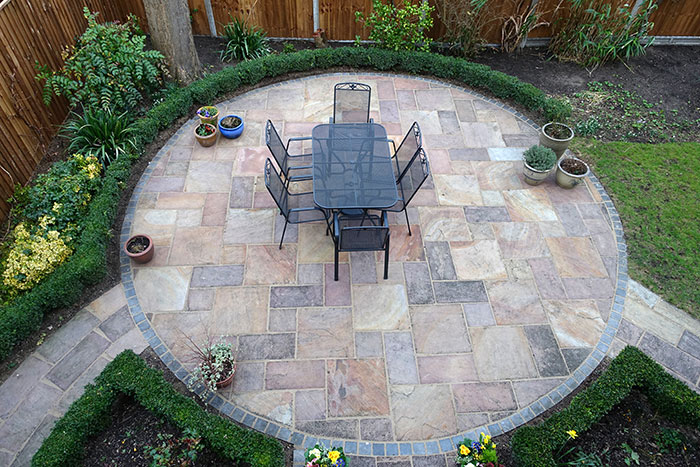
Planting around the edges of your outdoor room helps to create a soft edge, adds color, and offers limitless options for creativity.
6. Go green
Adding plants around the edge of your new outdoor space is a great way to soften the edges and create a pleasing contrast with the stone and wood elements elsewhere in your setup. Adding plants at the borders of your space can provide privacy and prevent the feeling of the space trailing off as your pavers or patio meet the grass.
The possibilities for planting really are endless. But Halstead warns homeowners against simply browsing the web for flowers that look the most attractive and picking them up at the greenhouse. That could result in plants that create a lot of mess or attract stinging insects, or plants that “look great going in the ground but are gone six months later” due to deer.
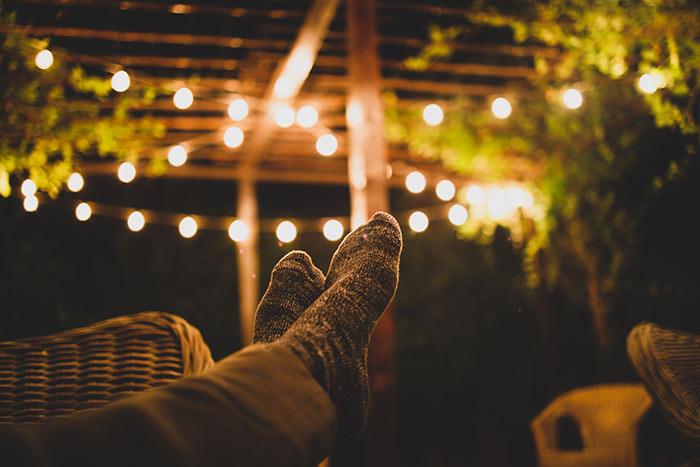
Don’t go all out on your outdoor room only to leave the illumination to a single porch light. By keeping the light soft and spreading it out, you can create a much more pleasant space.
7. Let there be light(s)
A typical backyard will usually have at least one light attached to the house, usually a pretty bright one. This works for basic illumination but leaves a lot to be desired for ambiance. Halstead recommends installing multiple low-voltage lights around your outdoor space. Possible ideas include uplighting against the house or moonlighting in trees. Make sure to always illuminate steps to reduce the possibility of trips and falls.
Electric lighting is the most common, but many homeowners choose to use gas lights as well if they have a natural gas hookup. Gas lights offer a kind of retro elegance with mellow brightness and tend not to attract insects the way electric lights do. If you opt for electric lighting, make sure you use LEDs to conserve energy. LEDs are available in many sizes and shapes and most are dimmable.
Another option is to buy some tiki torches and arrange them around the perimeter of your space. In addition to the standard-issue, bamboo tiki torch, with a refillable reservoir of fuel in the top, there are also torches available that include citronella to ward of mosquitoes, flameless solar “torches” that charge up by day and illuminate using surprisingly flame-like LED lights by night, and permanent installations made of more durable materials and fed by underground gas line.
Thanks to Jennifer Halstead of Halstead of Harmony Hill Landscaping Inc. in Fishkill for offering ideas and sharing photos for this article.


